
Condensor microphone with an audio analyzer
Physikfan, Sun Aug 27 2017, 12:26PMWith the help of this audio analyzer, I would like to record the frequency response of a condenser microphone.
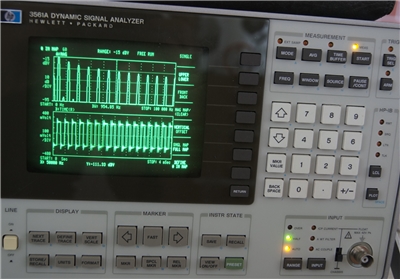
However, I still have the problem that I cannot connect the condensor microphone directly to the audio analyzer.
For the operation of this microphone I need a DC voltage of about 40V DC.
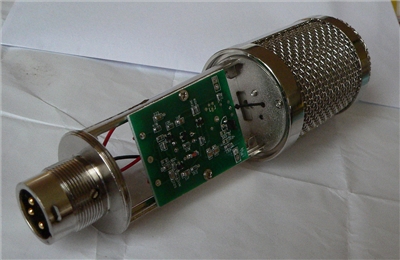
The board inside the microphone in detail:
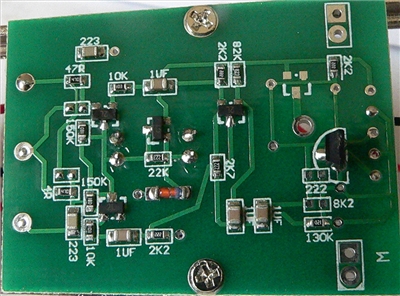
My question:
Please, could somebody help me how to do with this condensor microphone,
Is there a commercial module that provides this necessary voltage, or do I need a preamplifier?
VG
Physikfan
Re: Condensor microphone with an audio analyzer
hen918, Sun Aug 27 2017, 05:46PM
You could just feed it with the required 40 V from an external source via a circuit like this and connect the microphone to the analyser. You will need to make sure the power supply is floating wrt the analyser input as you'll either need to connect the negative to the gnd of the analyser or use a differential probe.
and connect the microphone to the analyser. You will need to make sure the power supply is floating wrt the analyser input as you'll either need to connect the negative to the gnd of the analyser or use a differential probe.
hen918, Sun Aug 27 2017, 05:46PM
You could just feed it with the required 40 V from an external source via a circuit like this
 and connect the microphone to the analyser. You will need to make sure the power supply is floating wrt the analyser input as you'll either need to connect the negative to the gnd of the analyser or use a differential probe.
and connect the microphone to the analyser. You will need to make sure the power supply is floating wrt the analyser input as you'll either need to connect the negative to the gnd of the analyser or use a differential probe.Re: Condensor microphone with an audio analyzer
Hazmatt_(The Underdog), Mon Aug 28 2017, 02:35AM
Seriously?
Just go to Guitar center and buy a preamp, it's like $40.
It's no where near the cost factor of the analyzer! That thing must be at least $2500 used!
I got my phantom unit with the mic and boom stand for like $80 out the door. Just buy one, it's not like it's a unique problem that needs engineering.
Hazmatt_(The Underdog), Mon Aug 28 2017, 02:35AM
Seriously?
Just go to Guitar center and buy a preamp, it's like $40.
It's no where near the cost factor of the analyzer! That thing must be at least $2500 used!
I got my phantom unit with the mic and boom stand for like $80 out the door. Just buy one, it's not like it's a unique problem that needs engineering.
Re: Condensor microphone with an audio analyzer
radiotech, Mon Aug 28 2017, 07:16AM
Just hang 3 9 volt batteries with two 4.7K resistors connected as per diagram.
Buy an extra M and F XLR connector. Close up the microphone before it gets destroyed.

radiotech, Mon Aug 28 2017, 07:16AM
Just hang 3 9 volt batteries with two 4.7K resistors connected as per diagram.
Buy an extra M and F XLR connector. Close up the microphone before it gets destroyed.

Re: Condensor microphone with an audio analyzer
Sulaiman, Mon Aug 28 2017, 08:46PM
When it comes to measuring frequency response, powering the microphone is the least of your problems,
what will you use as a calibrated sound source ?
I've not used speakers to measure microphones but I have used microphones to measure loudspeakers,
(microphones have a flatter frequency response than loudspeakers)
the easiest method that I found was to put the speaker on its back above ground level outdoors, with the microphone suspended 1m above the cone.
Unless you have an anechoic chamber, indoor frequency response plots will have massive peaks and troughs, and be position dependant, due to room resonances.
Sulaiman, Mon Aug 28 2017, 08:46PM
When it comes to measuring frequency response, powering the microphone is the least of your problems,
what will you use as a calibrated sound source ?
I've not used speakers to measure microphones but I have used microphones to measure loudspeakers,
(microphones have a flatter frequency response than loudspeakers)
the easiest method that I found was to put the speaker on its back above ground level outdoors, with the microphone suspended 1m above the cone.
Unless you have an anechoic chamber, indoor frequency response plots will have massive peaks and troughs, and be position dependant, due to room resonances.
Re: Condensor microphone with an audio analyzer
radiotech, Mon Aug 28 2017, 10:23PM
In 1976, we did a lot of speaker testing using Bruel & Kjaer gear . The pickup was a B&K calibrated mike, It was
expensive and came in a special case.
Here are the HP mikes you may be able to find.
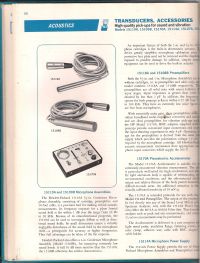
radiotech, Mon Aug 28 2017, 10:23PM
In 1976, we did a lot of speaker testing using Bruel & Kjaer gear . The pickup was a B&K calibrated mike, It was
expensive and came in a special case.
Here are the HP mikes you may be able to find.

Re: Condensor microphone with an audio analyzer
klugesmith, Tue Aug 29 2017, 01:02AM
And how does one calibrate a reference microphone?
You could begin with a pistonphone, made by companies like B&K, and still in the catalogs today.
Microphone Under Test connects to a small cavity in which the sound pressure is known with absolute accuracy better than 0.1 dB.
Cavity volume is modulated sinusoidally at 250 Hz by tiny cam-driven pistons.
To use one properly, you should account for the DC (ambient) pressure, and the internal volume of the MUT.
I wonder how big is the 250 Hz cyclical temperature variation that goes with a 124 dB pressure variation in air?
Here are a pistonphone datasheet: and a picture with what I guess are primary and secondary standards:
and a picture with what I guess are primary and secondary standards:
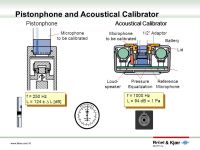
[edit] Also if you care about absolute accuracy, know your sound field type. "The three types of measurement microphone are free field, pressure field, and random incidence. These microphones operate similarly at lower frequencies but differently at higher frequencies."

klugesmith, Tue Aug 29 2017, 01:02AM
And how does one calibrate a reference microphone?
You could begin with a pistonphone, made by companies like B&K, and still in the catalogs today.
Microphone Under Test connects to a small cavity in which the sound pressure is known with absolute accuracy better than 0.1 dB.
Cavity volume is modulated sinusoidally at 250 Hz by tiny cam-driven pistons.
To use one properly, you should account for the DC (ambient) pressure, and the internal volume of the MUT.
I wonder how big is the 250 Hz cyclical temperature variation that goes with a 124 dB pressure variation in air?
Here are a pistonphone datasheet:
 and a picture with what I guess are primary and secondary standards:
and a picture with what I guess are primary and secondary standards:
[edit] Also if you care about absolute accuracy, know your sound field type. "The three types of measurement microphone are free field, pressure field, and random incidence. These microphones operate similarly at lower frequencies but differently at higher frequencies."


Re: Condensor microphone with an audio analyzer
Physikfan, Wed Aug 30 2017, 08:31PM
Hi hen918, Hazmatt_(The Underdog), radiotech, Sulaiman and klugesmith
Thank you very much for your links and comments, which have helped me a lot.
Meanwhile, I think I know now how to connect the condenser microphones and what a phantom power supply means.
Today I bought a mixer Q502USB by Behringer, whereby a microphone input with XLR jack allows the phantom power supply of 48V.
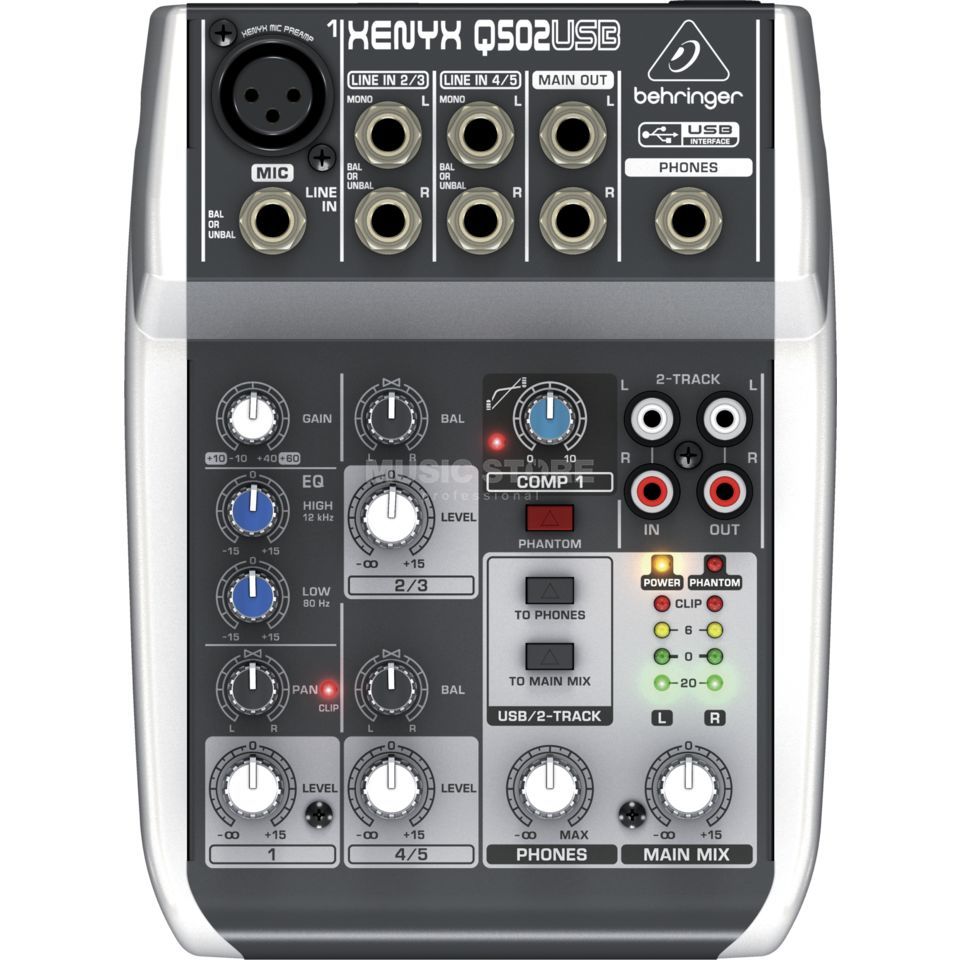
I hope I can present very soon first results with the microphones.
Also I would like to respond to your hints in detail.
Best regards
Physikfan
Physikfan, Wed Aug 30 2017, 08:31PM
Hi hen918, Hazmatt_(The Underdog), radiotech, Sulaiman and klugesmith
Thank you very much for your links and comments, which have helped me a lot.
Meanwhile, I think I know now how to connect the condenser microphones and what a phantom power supply means.
Today I bought a mixer Q502USB by Behringer, whereby a microphone input with XLR jack allows the phantom power supply of 48V.

I hope I can present very soon first results with the microphones.
Also I would like to respond to your hints in detail.
Best regards
Physikfan
Re: Condensor microphone with an audio analyzer
Sulaiman, Thu Aug 31 2017, 06:45AM
an idea;
IF you can place a microphone of known frequency response very close to the microphone under test
then all you need to measure is the difference in frequency response and add it to the frequency response of the reference microphone.
This would eliminate non-linearities in loudspeaker response.
Using the phantom power of the microphone input of the mixer is ok
but if you use the mixer amplifier then you need to measure its frequency response also, to be sure it is flat.
Sulaiman, Thu Aug 31 2017, 06:45AM
an idea;
IF you can place a microphone of known frequency response very close to the microphone under test
then all you need to measure is the difference in frequency response and add it to the frequency response of the reference microphone.
This would eliminate non-linearities in loudspeaker response.
Using the phantom power of the microphone input of the mixer is ok
but if you use the mixer amplifier then you need to measure its frequency response also, to be sure it is flat.
Print this page